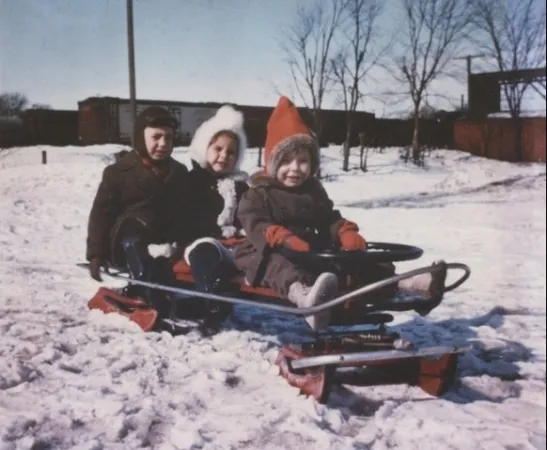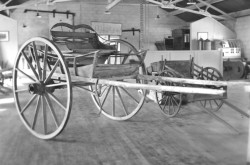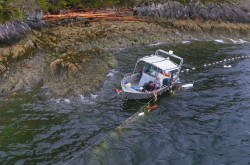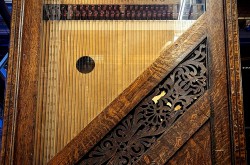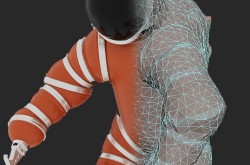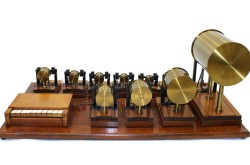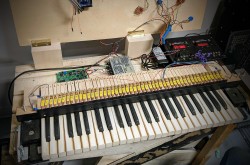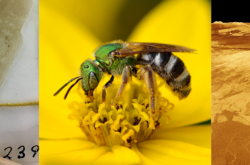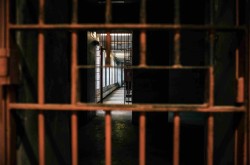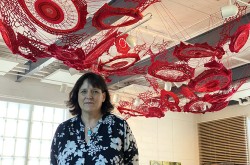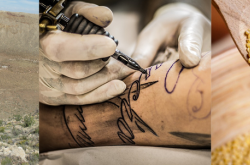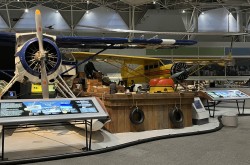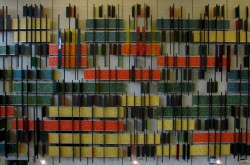Rediscovering the Dudley bobsled

By William Knight and Bruce Dudley
Some museum artifacts are mysterious. They lack provenance, or history, so we don’t know who made or used them, or why. Occasionally, however, objects acquire stories. Such is the case with a bobsled exhibited in Artifact Alley in the Canada Science and Technology Museum in Ottawa.
The bobsled, it turns out, has a rich history that connects winter fun, Ottawa’s transportation history, and the Great Depression—and memories of a beloved father.
As lead curator of Artifact Alley – a gallery that spans the renovated museum – I chose the bobsled in the summer of 2016. My responsibility was to select the objects for Artifact Alley’s eight massive cases. Each case has a theme and I found the sled while I was searching for artifacts for our Winter case.
When I first saw the bobsled, I was immediately struck by its length and vibrant red paint-job: but our catalogue was silent on its date and manufacturer. Apart from a donor’s name, we knew next to nothing about the sled. We estimated its date of manufacture between 1920 and 1968 (the year it was donated).
Despite this lack of information, it was perfect for our Winter case, which highlights the technologies of winter. The sled is now on exhibit alongside a cariole from Quebec that dates from 1835, a Kitty Cat snowmobile from 1973, an ice-hockey sledge from 2010, and an undated toy sled.
One day this past winter, my colleague Molly McCullough forwarded me a Facebook post from Stewart Dudley. The post described how Stewart and his father, Bruce, were delighted to discover the bobsled in the museum, which reopened to visitors in November 2017. Bruce immediately recognized it as his own childhood sled; it was built for him and his siblings in the 1930s by his father, Hector Dudley.
Bruce was kind enough to supply photographs, captions, and some details about the sled, which we will use to update the sled’s catalogue record. Bruce followed his father into a career as a streetcar operator; he is now a volunteer working to restore two streetcars once operated by the Ottawa Electric Railway.

"The picture was taken during the winter of 1937-1938 and a more precise date would probably be mid to late February 1938. The location is the south side of Catherine Street near Percy (we lived on Percy a couple of blocks north of Catherine at the time) and the railway boxcars up behind us are in the old CNR centre town yards, now the Queensway! The passengers are, front-to-back, my brother Garry Dudley, our cousin Margaret Dickson and me at the back. Margaret’s father, my uncle John Dickson took the photo. He was a photographer with the RCMP and was experimenting with Kodachrome at the time. He took this with an 8” x 10” view camera using Kodachrome sheet film. I’m sure the ASA or ISO rating could not have been more than 10."
~ Bruce Dudley

“This photograph of my father, OTC Inspector Hector Dudley, was taken at Holland Avenue Junction in late February 1954. I believe it was taken by the Newton photo agency as Hector had just received an award of some kind in recognition of his courteous service to the public.
Hector started work as a Motorman on the Ottawa Electric Railway (OER) in 1923, a time when streetcars in Ottawa were operated by two men. One man was the Motorman, located at the front of the car and he carried out all the functions relative to the driving of the streetcar. The other man was the Conductor, located in the rear area of the car and he took fares from and made change for passengers as they boarded the streetcar (via the rear doors in those days), and distributed transfers. In the early 1930s, the company changed their streetcar operations from its long established two-man arrangement. With the Great Depression in full swing the company combined the two seniority lists of the former conductors and motormen into one and laid off a substantial number of employees, including my father.
By about 1936, he was re-hired to work nights in the OER bus garage where he stayed for about three years, getting back on the streetcars in early 1939. It was during 1937 that he hand-made the sleighs in his off-time at home and during his break time at the bus garage. When we moved to Laurentian View (adjacent the east side of Westboro) in late 1939, my brother and I put the sled to great use."
~ Bruce Dudley

“As you can see, a tubular rail extended from ahead of the steering wheel (which probably came from an old bus or car) and down along both sides of the main board. It was spaced from it by short members connecting to the board, and provided foot rests for the passengers.
Another feature that Hector built into the unit was a retrieving tow rope, located on the front sled just ahead of the steering wheel base. You pulled this out to tow the sled back uphill, and when you got there, you let it go and the retriever wound the rope in again.
I’m not sure how long it took him to make the bobsled, maybe six to eight months, maybe more. A friend of his at the bus garage did the original paint work that included some fantastic hand-striping. Apparently, the man did all the fancy paint work on the buses at that time.
In the late 1950s my parents moved out to a new house that Hector built at Heart’s Desire – near the Jock River Bridge on the Prescott Highway – but they decided to sell their home in the early 1970s. It was at that time that Hector gave the sled to the Science and Tech Museum. I think he also gave them a smaller, utility type sled as well. It had a shorter, wider platform and a wagon-type handle for pulling purposes.”


